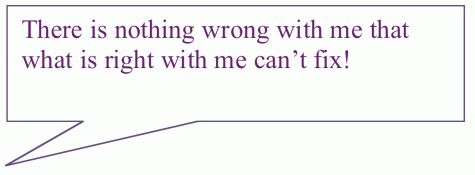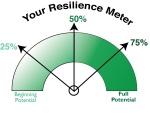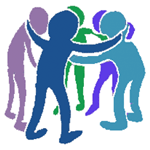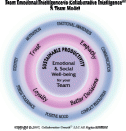 The next time you find yourself “too tired” to exert self-control, challenge yourself to go beyond that first feeling of fatigue.
The next time you find yourself “too tired” to exert self-control, challenge yourself to go beyond that first feeling of fatigue.
The Willpower Instinct, Kelly McGonigal, Ph.D.
Here’s a quick quiz, to give you perspective on your current well-being.
- Do you like your life and smile often?
- Are you reasonably happy with your weight and other health-oriented decisions?
- Are you aware of something important to you that’s bigger than you? For some this is met through religion or spirituality, for others it’s science or community service.
- Do you invest in building strong social connections?
- Do you feel productive?
- Are key economic factors in place for you and your family, especially food, housing, and transportation?
A resounding yes to all is the desired state, but we’re on planet earth, right? So, we might say: “My weight isn’t bad, but I’d like to lose 10 pounds and exercise more.” “My work is productive but takes so much of my time that social connections suffer.” And so on. A life well lived is one that focuses on continuing to experience well-being in accordance with our evolving needs. This article will address some of the ways we can strengthen our willpower muscles to expand our well-being.
Well-being is a broad, life encompassing concept. Willpower is a powerful strategy for conducting our lives in a way that promotes well-being.
Well-being Defined
The Centers for Disease Control (CDC) studies well-being due to its public policy implications. The CDC states:
Well-being is a positive outcome that is meaningful for people and for many sectors of society, because it tells us that people perceive that their lives are going well. Good living conditions (e.g., housing, employment) are fundamental to well-being. Tracking these conditions is important for public policy. However, many indicators that measure living conditions fail to measure what people think and feel about their lives, such as the quality of their relationships, their positive emotions and resilience, the realization of their potential, or their overall satisfaction with life—i.e., their “well-being.” Well-being generally includes global judgments of life satisfaction and feelings ranging from depression to joy.
Well-being considers our whole life. Key components include:
- Spiritual Connection or a Sense of Supporting Something Bigger than Oneself
- Physical Health
- Mental Health
- Emotional Health
- Social Connectedness
- Productivity with Self-Actualization
- Economic well-being
- Healthy Physical Environment
- Life Satisfaction
Willpower
Willpower is one of our primary strategies to support and expand well-being. Willpower is defined by Dr. McGonigal as
The ability to control our attention, emotions, and desires – and influences our physical health, financial security, relationships and professional success.
Here are some strategies for tapping into your willpower in ways that enhance your well-being. We strongly recommend Kelly McGonigal’s book, The Willpower Instinct! The ideas below are influenced by her work.
Choose one area where you’d like to improve your life. Conduct a reality check, be sure that it’s viable for you given everything else happening.
Your emotional intelligence skills of Self-Awareness and Impulse Control are vital to engaging your willpower. As McGonigal says, “When we [combine these skills] we will find the willpower and the want power to do the harder thing.” (p. 28) Humans have the gift of being able to observe ourselves and even to predict what we will do and the likely outcome if we’re willing to exercise our skill (or not). Once you activate your awareness your question is will you engage your Impulse Control so you further that willpower goal and improve your life? We know this can be hard so let’s look at steps to build your skills.
- Develop improved self-awareness. One way to do so is by committing to notice your responses when a certain type of event (you choose) occurs. Write down a few notes so you can keep track, and do this until you have a good idea of what to change to meet that new life goal.
- Now that you’re considerably more aware, it’s time to build your impulse control muscles. These “muscles” are in the pre-frontal cortex and McGonigal assures us that the brain will remodel itself based on what we ask it to do. Perhaps surprisingly, likely the best way to do so is to meditate – even 5 minutes a day. She writes:
Neuroscientists have discovered that when you ask the brain to meditate, it gets better not just at meditating, but at a wide range of self-control skills, including attention, focus, stress management impulse control and self-awareness. People who meditate regularly aren’t just better at these things. Over time, their brains become finely tuned willpower machines. Regular meditators have more gray matter in the prefrontal cortex, as well as regions of the brain that support self-awareness. (p. 24)
- Integrate your self-awareness and impulse control through a Pause and Plan strategy. As McGonigal points out, this is vastly different than fight or flight. Pause and plan is based on slowing down, being aware, considering various outcomes and making a considered decision.
Whether you want to improve your weight, exercise more, quit smoking or be more pleasant with your family, using the powerful emotional intelligence skills of Self-Awareness and Impulse Control so that you have the time and awareness to engage the Pause and Plan strategy will help you meet your goal.

 How was your 2016? We know it was challenging for many in the world. There’s a strong sense of divisiveness in communities and nations, war, displacement, financial troubles. Instead of continuing to list and focus on challenges, let’s move toward what is right.
How was your 2016? We know it was challenging for many in the world. There’s a strong sense of divisiveness in communities and nations, war, displacement, financial troubles. Instead of continuing to list and focus on challenges, let’s move toward what is right.





 Collaboration is a result of people working together to reach a mutual answer to a challenge or opportunity. As our world becomes more integrated and boundaries become more blurred the need and desire to collaborate is heightened. We see this on the internet, such as with Wikipedia, in organizations of all sizes and shapes, such as the better efforts at the United Nations and in performance goals for individuals and leaders, such as the Executive Core Qualifications (ECQ’s) that leaders in the federal senior executive service are to meet.
Collaboration is a result of people working together to reach a mutual answer to a challenge or opportunity. As our world becomes more integrated and boundaries become more blurred the need and desire to collaborate is heightened. We see this on the internet, such as with Wikipedia, in organizations of all sizes and shapes, such as the better efforts at the United Nations and in performance goals for individuals and leaders, such as the Executive Core Qualifications (ECQ’s) that leaders in the federal senior executive service are to meet. Collaborative Intelligence™ is a key outcome teams can reach as they build their skills.
Collaborative Intelligence™ is a key outcome teams can reach as they build their skills. 